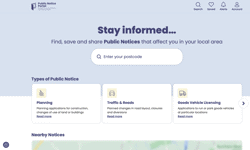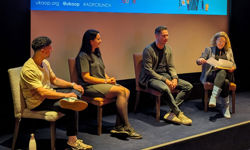I once worked with a chief-sub who, irritatingly, described himself as a drawer of boxes. Sadly, in the modern newspaper world of unimaginative templating and two-deck headline syndrome, we are now awash with his type - Mac pilots who have never understood that the essence of layout is story-telling.
There is no shortage of so-called designers who can draw modular shapes with layers, cutouts, perfect spacing and linear blends. But how many of them measure the words, rather than weigh them? How many of them read the copy to the end, edit it to what it is worth, write the headlines first and then make the content dictate the page? There are some notable exceptions, particularly on the national tabloids, but there are many more who believe page layout is about drawing shapes and making the content fit.
The cover of a newspaper offers the opportunity to woo the casual or non-reader. The front-page designer should not be unduly worried about the regular readers, those who have the paper home-delivered, for they are already signed up. Front page design is about persuading those elusive people who set off that morning with no intention of buying the newspaper - to change their minds. When the non-reader is in the newsagents buying 20 Silk Cut and packet of Polos, the layout artist's job is to make him or her say ‘oh, and I'll take a copy of this too.’ And, as there are more publications on the shelves than ever before, this will never be achieved by merely filling space.
The first thing the layout artist needs to know is who the non-readers are - and what content interests them. What is it that might make the incomer to the area, the 25-year-old non-newspaper reader, the harassed working mother, pick up your paper today?
One thing is certain. If the paper looks the same as it did yesterday - two-deck headline in Helvetica Black caps, same depth blurb in dark blue, slightly off square picture of someone they have no interest in - then it will be the cigarettes and mints only, thanks.
The paper's layout should not look identical every day. It should offer variety and surprise.
It is also worrying how many layout artists still seem to believe that ink sells newspapers. It doesn't. The age of the big black one-word headline should have long passed, although there is plenty of evidence that it drags on and on in evening newspapers.
Words do, of course, sell newspapers. But the drip-drip effect of predictable splash headline words such as attacks, boost, drugs, shame, vandals, thieves, crash, jobs blow have become bland and invisible on the newsstands.
Good headline writers need to use words that build immediate and vivid pictures in the minds of their potential readers. I have hundreds of examples of splash headlines that fail to do this - a large weekly paper that says ‘Plans promise jobs bonanza’, an evening that says ‘Youth crime blitz boost’.
The kindest thing I can say about these headlines is that if you threw the words in the air, and they came down in a different order, they would still mean the same - absolutely nothing.
Both headlines are, predictably, two decks, a common shape, with the words made to fit.
Headline writers also use words that they believe build pictures but don't. ‘Teenager’ does not give us gender, neither does ‘pensioner’ – and, these days, the description could span 50 years. I would rather have Emily, 15 or George, 86.
The headline
One of the fundamental rules of layout is to write the headline first. When Concorde crashes into a hotel outside of Paris, the word ‘Concorde’ has to go into the headline. ‘Fast jet’ or ‘plane’ are not quite the same. If ‘wheelbarrow’ or ‘hairdresser’ is germane to the story then I would suggest a horizontal headline. If a man, whose arm has been bitten off by a tiger, comes up with the quote: ‘The tiger went chomp, chomp, chomp as he ate my arm, it quite wrecked my day,’ then we are talking vertical, narrative and lower case. And that is exactly what the Daily Mirror did.
The national tabloids are very adept at this. The Sun's famous ‘Zip me up before you go go’, when George Michael was caught misbehaving in a public loo, is a terribly shaped headline. So is ‘Freddie Starr ate my hamster’. But who cares? Both were clearly written first and the front page built around them.
There is plenty of evidence that too many layout artists find this concept too difficult to grasp.
The blurb
Another front page ‘selling’ device, that is now prevalent, is the blurb, the sky box, the promo panel - call it what you will. It is usually a coloured strip that sits below, or sometimes above, the titlepiece.
This is a fairly recent phenomenon. The first issue of the Sun, from 1964, has a front page teaser which said ‘Win a house, a car or £10,000’. This must have been a huge giveaway back then, yet it sat underneath the fold on a broadsheet paper. Today it would dominate.
The sole purpose of the blurb is to sell the paper; to tease the elusive non-reader to pick it up. How many times do we see the opportunity wasted? Common words in newspaper blurbs are ‘plus’ (often in red caps) and ‘inside’ (where else would it be?). When the designer has limited space to sell the content of the paper, why use such dead words?
I have seen newspaper blurbs that say ‘Meet the new Lord mayor’, ‘the staying power of books’, ‘free doormat offer’, ‘next week win a rocking baby chair’. I wonder how many extra copies they sold?
Regional newspapers also seem to be obsessed with the number of pages they are offering – ’16 pages of jobs today’, ’32 pages of property’, ‘48 pages of ink and newsprint’. Do they believe readers want width rather than quality?
A couple of years ago, my sons bought me a copy of Rolling Stone magazine at San Diego airport. They had been attracted to the cover line that read ‘The 100 greatest guitarists of all time’, alongside a picture of Jimi Hendrix in full flight. We killed an hour by trying to name the top ten - a conversation that would not have taken place had the coverline said ‘96 pages today’. It is the content, not the pagination that sells.
Other common mistakes in blurbs include:
* The wrong choice of typefaces.
Impact, a face with tiny bowls, is regularly used, sometimes with a shadow. Capital letters, that are hard to read (which is why road signs and cigarette warnings are in lower case), are prevalent.
* Inappropriate colours.
Blue does not work on top of red in newsprint, neither does green nor black. I have seen all combinations used on blurbs. The words should be in the hotter colour - so why yellow for the background? Blends, that often make the paper look like it is underinked, are too fussy a device.
* Too many items.
On a tabloid, one or two is most effective. This is not the place for an index.
* Page numbers used the same size as the message.
The page is the least interesting part of the blurb. Magazines don't use page numbers at all on their coverlines.
* Reduced front covers of supplements.
The pictures are then reduced to pinheads and the coverlines to 6pt. It is the content of the supplement that might sell, not the mere fact it exists.
The pictures
Finally, to pictures. September 11, 2001, demonstrated how crucial photography is to newspapers. It may have been a huge story, but the words were secondary - every national newspaper led on a single photograph. The Guardian, a newspaper in which words and analysis are the bedrock, used only 11 words on its first three broadsheet pages.
The day after Diana died, the Sun used a beautifully cropped wraparound of the airmen carrying her coffin. It may have been the biggest story of the 90s, but the Sun chose to use its smallest headline of the decade - Goodnight sweet princess - at the foot of the page.
A compelling picture, well-cropped and positioned in the top half of the page will always draw the reader’s eye. Magazines have known this for years.
Layout isn't rocket science. It involves placing words, images and space on a piece of paper. Anyone can do it. Desktop publishing means the school magazine and church newsletter have become far slicker. Effective layout is a different matter. It is about using imagination and creativity, about having a story to tell, a message or an emotion to convey, and getting it across with impact.
I leave you with three examples. In 1991, when I was editing the Northern Echo, a man called Albert Dryden shot dead a council officer in a planning row over a bungalow. Photographer Mike Peckett took pictures of the event and we used 11 of them in a sequence across page one. The sale of the paper rose by 8% that day. Why? I would maintain it was because we looked so different to all the other papers on the stands.
The day after Thomas Hamilton walked into a school in Dunblane and shot dead 16 children, the nationals were torn between using a page one picture of the children or the killer. The Mirror turned the classroom picture into 22 separate pictures and ran them around page with Hamilton in the centre.
Last year, when the IRA announced its ceasefire, the Irish Examiner set the names of all 3,530 victims of the troubles across its broadsheet cover. The bold type in the middle formed the silhouette of an IRA gunman firing in the air.
What do they have in common? All were compelling front pages that sold extra newspapers. And none were created by the drawers of boxes.
FEATURE
Design that sells
A compelling front page sells extra copies. Simple! You’d be hard pushed to find anyone who disagrees with that statement. Why is it then, asks Peter Sands, that newspapers so often fail to do themselves justice in this crucial area of sales and marketing?










